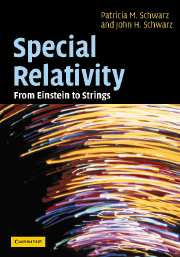Book contents
- Frontmatter
- Contents
- Preface
- Part I Fundamentals
- 1 From Pythagoras to spacetime geometry
- 2 Light surprises everyone
- 3 Elements of spacetime geometry
- 4 Mechanics in spacetime
- 5 Spacetime physics of fields
- 6 Causality and relativity
- Part II Advanced Topics
- Appendix 1 Where do equations of motion come from?
- Appendix 2 Basic group theory
- Appendix 3 Lie groups and Lie algebras
- Appendix 4 The structure of super Lie algebras
- References
- Index
3 - Elements of spacetime geometry
Published online by Cambridge University Press: 06 July 2010
- Frontmatter
- Contents
- Preface
- Part I Fundamentals
- 1 From Pythagoras to spacetime geometry
- 2 Light surprises everyone
- 3 Elements of spacetime geometry
- 4 Mechanics in spacetime
- 5 Spacetime physics of fields
- 6 Causality and relativity
- Part II Advanced Topics
- Appendix 1 Where do equations of motion come from?
- Appendix 2 Basic group theory
- Appendix 3 Lie groups and Lie algebras
- Appendix 4 The structure of super Lie algebras
- References
- Index
Summary
Hands-on exercise: manifolds and coordinate patches
To complete this exercise you will need the following supplies:
Two rulers or other rigid length-measuring sticks.
Large flat surface like the top of a table or desk, similar to that used in the Chapter 1 hands-on exercise.
Large spherical object (LSO), similar to that used in the Chapter 1 hands-on exercise.
A device for measuring time.
Build a model of E2 (two-dimensional Euclidean space) with two rulers taped together at right angles to make rectangular coordinate axes. Place the coordinate axes on the surface of the table or desk that you used in the Chapter 1 hands-on exercise so that the corners are touching the surface. Move them around to see what it means for the surface to be both locally and globally like E2. Could you accurately measure the distance between any two points on this surface using only these straight axes, if they were long enough and couldn't bend?
Place the axes on the surface of the LSO that you used in the Chapter 1 handson exercise so that they are tangent to the surface. Move them around from point to point and ponder what it means for the surface to be locally but not globally like E2. Could you accurately measure the distance between any two points on this surface using only these straight axes, if they were long enough and couldn't bend?
- Type
- Chapter
- Information
- Special RelativityFrom Einstein to Strings, pp. 55 - 94Publisher: Cambridge University PressPrint publication year: 2004

